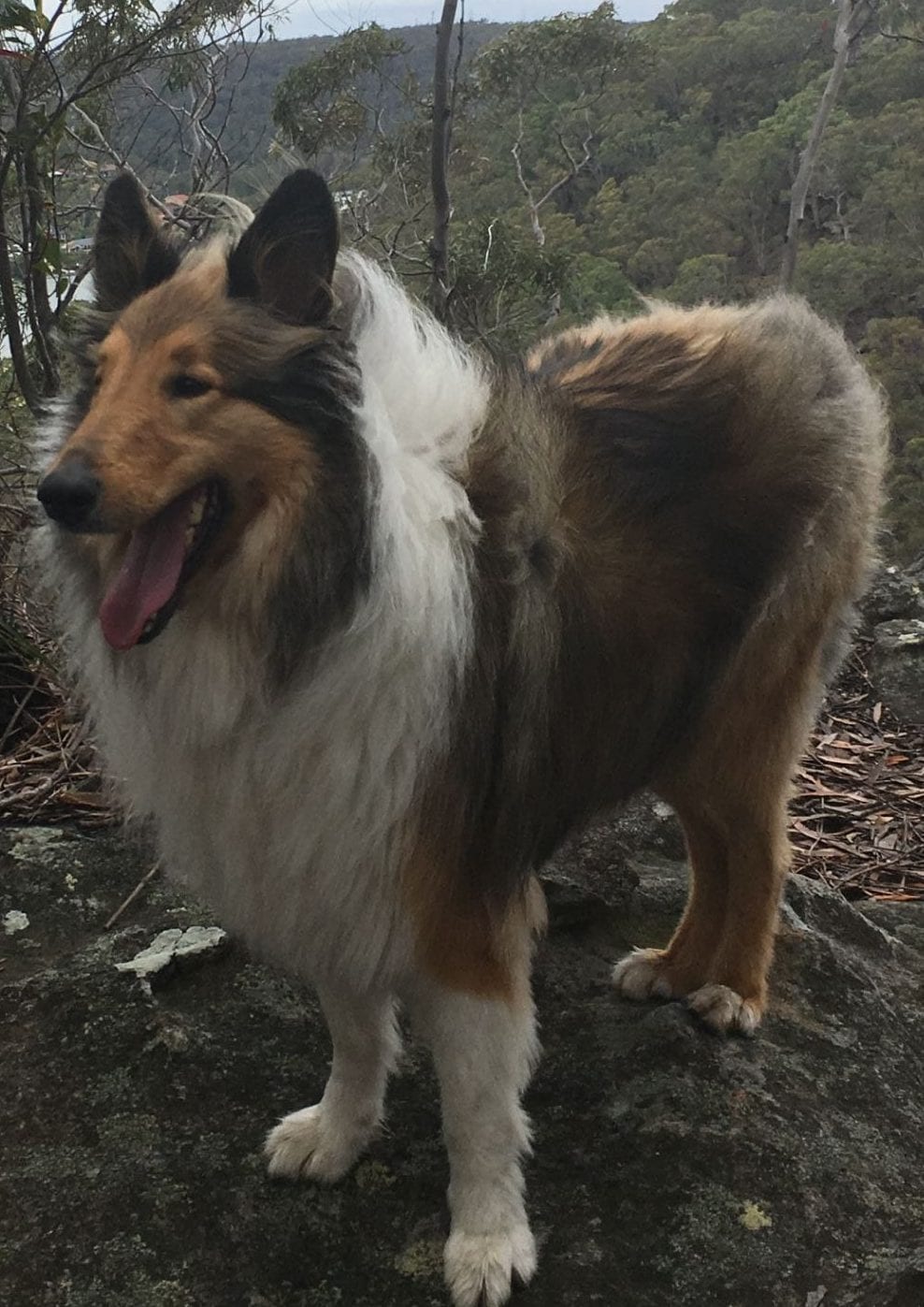Part A: Statement of personal philosophy
An effective teacher librarian (TL) is an innovative educator who is passionate about information resources and life-long learning. They have a strong advocacy voice, demonstrating leadership and fostering valuable working relationships with all members of the school community. A successful TL is an information professional who embraces technology and drives the development of student information literacy. Through a solid understanding of educational theory and the curriculum, a TL collaborates to facilitate the development of student knowledge, understanding and skills. They create a rich and welcoming library environment that operates as a centre for learning within the heart of the school.
Part B: Learning themes
Theme 1: Leadership
Early on in this course I completed ETL 504 Teacher librarian as leader and attempted to visually represent the leadership roles of the TL within the school in a concept map. Whilst I was able to identify a variety of leadership styles that a TL might assume within their role, I greatly underestimated all of the connections that a TL has within the school community and their leadership of these as seen in Figure 1 (Linquist, personal communication, August 23, 2019). What became clear to me through this process, and in reflecting on the feedback, was that often these connections or partnerships don’t just happen organically. Invariably it is the TL who must lead this, forging collaboration and promoting their role and the library within the school community. Professional commitment as a TL involves the demonstration of leadership within school and related expert communities (Australian Library and Information Association (ASLA), 2004). This leadership offers opportunities for the TL to advocate for, and demonstrate the significance of their expertise and the overall importance of the library to the community. When the TL demonstrates leadership there is an opportunity to make an impact on student outcomes and also highlight the significance of their role to the entire school community (Long & Jones, 2016).
Figure 1: My concept map for ETL 504 Teacher librarian as leader (Linquist, personal communication, August 23, 2019).

I gained great insight into my own leadership capabilities in completing the Group work case studies which were part of ETL 504. In my blog post (Linquist, 2019c) I reflected on how my understanding of leadership and collaboration grew through this case study process. I naturally found myself taking on the responsibility of group organiser and initiated contact and interactions with members. I acknowledged that sometimes a leader emerges through necessity, and as a consequence of analysing the nature of the situation and tasks at hand. Through this process of collaboration with peers I was able to experience group dynamics and navigate through some hurdles. I came to appreciate that collaborating with others can sometimes be challenging, but that establishing clear roles, responsibilities and goals is essential. It made me more aware that leadership as a TL will entail carefully managing a multitude of working relationships.
As part of my role as a classroom teacher, inspired by my study of this course, I was able to collaborate with the school’s TL to develop a research guide for students. An example of what was produced can be seen in Figure 2 (personal communication, November, 2019). The TL took leadership of the creation of this research guide by initiating a process of consultation with staff and students. I was part of the team who trialled its implementation with classes across year groups, but the TL led the organisational process. Additionally, they were responsible for obtaining and analysing the feedback from this initial implementation process. The feedback was then carefully considered and amendments made to ensure that it achieved its purpose of supporting student research. It was evident from the leadership of this process, that the TL was passionate about making a difference to student learning. Furthermore, the collaboration process served a dual purpose as it also promoted the work of the library and its staff to the community. I was able to see the value of a TLs work and their leadership of projects designed to assist teaching and learning through the lens of a teacher (but one who is also studying teacher librarianship).
Figure 2: Draft school research framework checklist (personal communication, November, 2019).
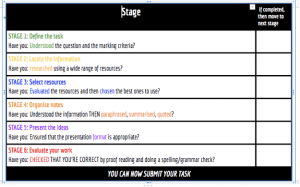
During my work placement I was fortunate enough to shadow JMC Academy’s National library Manager and witness her leadership of the library staff and facilities. I was able to see how she drove collaborative partnerships with teaching staff. I also saw how she led the process of adapting to technological changes to facilitate student learning. One of the projects that she was leading was the Academy’s implementation of a library remote help desk. This was in response to the ongoing impacts of the Covid-19 pandemic and the greater utilisation of remote learning. This project involved her hosting numerous meetings with the Academy’s Information Technology department to articulate its operational requirements. When I arrived at my work placement I was quite surprised to see how small the physical library space was as seen in Figure 3 (Linquist, 2022). However, the National Library Manager explained that she had just led a major refurbishment of the space and downsizing of the physical shelving space. This is in response to the changing information environment whereby online access to library resources, such as databases and e-books is increasingly commonplace. This highlighted to me that as a TL it is vitally important to not only embrace technological changes but to lead their implementation in an educational environment.
Figure 3: Part of JMC Academy Library (Photograph).
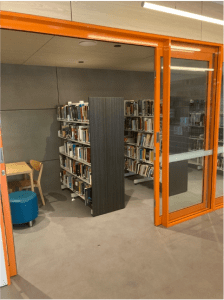
Theme 2: Resourcing and supporting the curriculum
In completing this course, I have gained an appreciation of the significant role that a TL plays within the education environment, and particularly in resourcing the curriculum. An effective TL has knowledge of the curriculum, educational theory and student learning needs. Excellent teacher librarians have a thorough knowledge of literacy, literature, the curriculum and specific school programs (ASLA, 2004). Prior to my engagement in this course, and despite having taught in a number of schools, my interactions with the TLs over the years had been very limited. As a classroom teacher I tended to view the library and its staff as a separate entity operating independently from my work as a teacher. However, through this course I have gained a better appreciation of the pivotal role that the library and its expert staff play within the educational sphere. As a classroom teacher I had underestimated the valuable expertise of the TL in terms of supporting information literacy and resourcing the curriculum. My learning inspired me to collaborate more with the TL in supporting and resourcing my teaching. I was able to see first-hand, as a classroom teacher, how an information professional’s expertise and knowledge of information resources enhances teaching and learning. What I have gained from these collaborative experiences will inform my future work to ensure I am an effective TL. It will drive me to establish strong partnerships with teachers to assist in resourcing the curriculum.
As a classroom teacher I have come to embrace a better working relationship with the TL at my school to support my teaching practice. In my blog post (Linquist, 2019b) I mentioned that any time I have collaborated with the TL to resource my teaching, the students’ learning has been enriched. Evidence of this was seen in teaching the history topic Australians at War to a year 9 class where I decided to incorporate picture books into the teaching program. This was inspired by the subject ETL 402 Literature across the Curriculum. I consulted with the TL to use their expertise in deciding which picture books would be the most appropriate for the students in my class. Two of the picture books recommended were The happiness box: a wartime book of hope by Mark Greenwood and Anzac Biscuits by Phil Cummings and Owen Swan. These picture books were a great platform that generated valuable discussion of the course content.
The TL at my school had expert knowledge of information resources available online that also encouraged me to incorporate more technology into my teaching. She was able to steer me in the direction of some good interactive resources to use in the classroom. One such resource that was recommended by her for a year 9 History class learning about World War II was Junko’s story (SBS Australia, n.d.). This recommendation was valuable as the age and gender of the author at the time of the events was similar to the students in the class. The positive student responses to resources that were recommended by the TL highlighted to me the value that can be gained through this collaboration in resourcing the curriculum. It prompted me to collaborate further with the TL for resources on the history topic Migration Experiences.
The collaboration with my school’s TL led me to utilise the school’s Library Management System Oliver, and in particular LearnPath. The TL demonstrated how to use LearnPath and provided me with further guidance regarding its resources. This gave me the confidence to explore it further and led to me using some ancient Egypt resources with my year 7 history classes as can be seen in Figure 4 (Oliver Domremy College, n.d). As I found these resources beneficial, I then worked with the TL to present this information about the benefits of LearnPath to all staff at a whole school meeting. With the ever-increasing work load of teachers, having easy access to quality resources to support the curriculum is essential. Having a TL that has in depth knowledge of the curriculum and resources to support it is invaluable.
Figure 4: Year 7 history LearnPath Ancient Egypt (Screenshot).
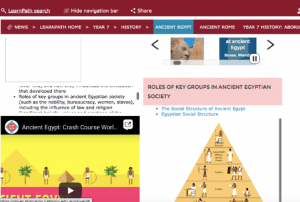
During my work placement, I was able to experience working on the other side of the collaboration partnership, this time as a TL. This involved working closely with teaching staff at the Academy to support their resourcing of the courses they were delivering. In doing this, my task was to develop a subject guide that provided their students with information about specific learning resources, their availability and how to access them through the library. My task was to also consider if there were other resources available through the library that would be beneficial to their learning. This subject guide was then made available to the students through the Academy’s learning management system see Figure 5 (JMC Academy, 2022). This was then promoted to other teaching staff and was very well received. Experience has shown that once a school librarian’s collaboratively planning with classroom teachers is publicised it leads to further successful planning partnerships (Bishop, 2011). It led to further collaborations with staff regarding supporting their resourcing of the curriculum. It reinforced to me that people often lack awareness regarding the valuable work that TLs do to support the curriculum and learning. To be a responsive and effective TL it is imperative to forge partnerships to resource teaching and learning in the educational environment.
Figure 5: JMC Academy Plato Design – Visual Communication subject guide (Screenshot).
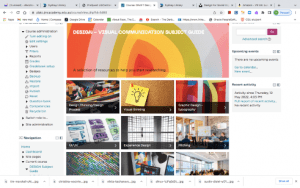
Theme 3: The Library as a learning hub
Prior to commencing this course, I had a very one-dimensional view of the function and purpose of a school library’s physical spaces. I primarily saw the library as a place where students go to read and borrow books. In reality I knew that there was much more to it than that, but it took me completing this course to really unpack its true value as a community learning hub.
A school library’s physical space is dynamic, welcoming, diverse, rich and educational. From puzzles, to origami making, to mindfulness activities such as colouring in, and reader’s clubs, the library offers many opportunities for learning that address diverse student educational needs and psychological wellbeing. The learning that occurs within this space is multifaceted and cross-curricular, addressing some of the Australian curriculum’s general capabilities such as critical and creative thinking. The general capabilities are important in developing students’ ability to live and work in the twenty-first century (Australian Curriculum, Assessment and Reporting Authority, 2021). One of the things that I did as part of my learning in this course was to work with the TL at my school to enhance the school library’s operation as a diverse learning hub. An example of some of the activities that were offered can be seen in Figure 6, an email I sent to the school community (Linquist, personal communication, December, 2019). It became evident to me through these activities that the library is able to offer a learning space for things that may not be appropriate in the classroom space. Furthermore, these activities offer a variety of different social interactions for students. These social interactions can also enhance student literacy and numeracy. Additionally, they also assist with the development of their verbal communication skills and further support classroom learning.
Figure 6: Activities on offer in the Library learning hub (Screenshot)
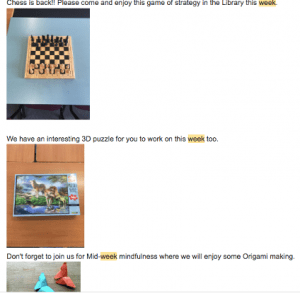
In my blog post (Linquist, 2019a) I indicated that in my view a well-functioning library is the heart of the school and can bring the entire school community together for many different reasons. I also mentioned that for some students a welcoming library is a haven that offers them solace and comfort (Linquist, 2019a). This rich welcoming space can be achieved through comfortable furniture, intriguing signage and stimulating visual displays. Furthermore, an effective TL can help to achieve this richness by modifying the environment in response to specific themes such as Book Week. This also helps to promote the school library as a dynamic and responsive learning space that is constantly changing.
One of the other key roles that the library plays in education is in embracing and facilitating information technology and digital storytelling. Offering opportunities for students to explore the digital world within the library is invaluable. Many students may not have access to such technology at home, so the school library becomes a place for access to this in a safe and monitored environment. In my blog post (Linquist, 2021) I indicated some of the benefits of digital storytelling, including the utilisation of a range of features not afforded to printed texts, that make them more appealing to the senses.
Makerspaces have become a popular inclusion in many contemporary school libraries. The addition of a makerspace affords opportunities for innovative learning, and an avenue for individual expression ensuring that libraries are seen as cultural and creative community hubs (Willingham & deBoer 2015). Makerspaces are also an opportunity for staff to utilise another space that can extend learning to outside of the classroom. I have seen science teaching staff using the library makerspace for students to work on producing models during lunch time. Furthermore, I have seen design and technology staff successfully using this space for jewellery making with students. One of the most significant yet secondary benefits of a makerspace is that it promotes the library to the whole school community. In particular, it highlights its role as an educational space for diverse and interesting learning opportunities. To be an effective TL it is important to ensure that the school library is seen as a welcoming and rich teaching and learning environment for all members of the school community.
Part C: Evaluation
This course has provided me with the educational theory pertinent to the work of a TL. The extensive information I have studied has reinforced to me the expertise that a TL has and how their role within the educational sphere is great and varied. What I appreciate is that my knowledge and skills are still in the fledgling stage, and will continue to develop as my journey progresses. The fact that this course had so many electives highlights that the work of a TL is so diverse. Furthermore, with the elective choices restricted to choosing only two, I know that I will need to continue my learning in areas where my knowledge can be further enriched. One of the areas where I know that my learning will be ongoing is in the area of digital citizenship. As this is such a rapidly changing landscape, it will be essential to keep abreast of these technological changes as an information professional.
This course provided me with a greater appreciation of the central role that the library plays within the school community. What I have learned through this course is that the TL is the driver of how significant this role is to the community. My attitude towards the significance of the library to the school community has changed. I now understand that as a professional TL my role will be of fundamental importance to the teaching and learning within the school.
Despite having gained significant knowledge and skills through studying this course, my work placement taught me that working as a librarian is a whole new experience. It made me appreciate that I still have so much to learn. Although there are many common elements to working as a TL, there are also workplace specific requirements that can only be learnt on the job. Each school has its own mission, values, culture and community which influences the operation of the school library. As a TL it will be necessary to address these individual characteristics and operate accordingly. This will involve carefully analysing the needs of the students and staff and the curriculum at the school. Expert TLs support the needs of the school community by facilitating an information-rich educational environment (ASLA, 2004). As a professional TL it will be important to network to share learning and ideas. An effective TL readily participates in education and library professional networks (ASLA, 2004). I will also endeavour to join my local TL professional network to learn from others and seek help when needed.
Life-long learning is an important aspect of working as a TL due to the ever-changing technological landscape. As an information professional, it will be important to promote life-long learning within the school community, including my own. To demonstrate professional commitment, TLs should model and promote life-long learning (ASLA, 2004). This professional commitment will also involve me continuing my process of education by attending professional development sessions to continually update my knowledge and skills. Although I have learnt so much through this course journey, I’m also looking forward to the challenges and ongoing learning that lays ahead as I embark on being a TL.
References
Australian Curriculum, Assessment and Reporting Authority. (2021). Australian Curriculum general capabilities. https://www.australiancurriculum.edu.au/f-10-curriculum/general-capabilities/
Australian Library and Information Association. (2004). ALIA-ASLA standards of professional excellence for teacher librarians. https://read.alia.org.au/alia-asla-standards-professional-excellence-teacher-librarians
Bishop, K. (2011). Connecting libraries with classrooms: The curricular roles of the media specialist. ABC-CLIO, LLC.
JMC Academy. (2022). JMC Academy Plato Design – Visual Communication subject guide [Screenshot]. https://www.jmcacademy.edu.au/
Linquist, D. [dikozlow] (2019a, March 14). The role of the teacher librarian in schools. https://thinkspace.csu.edu.au/dijl/2019/03/14/the-role-of-the-teacher-librarian-in-schools/
Linquist, D. [dikozlow] (2019b, May 22). Discussion forum 4.3 the TL and the curriculum. https://thinkspace.csu.edu.au/dijl/2019/05/22/discussion-forum-4-3-the-tl-and-curriculum/
Linquist, D. [dikozlow] (2019c, October 5). ETL-504 Part B-Reflection. https://thinkspace.csu.edu.au/dijl/2019/10/05/etl-504-part-b-reflection/
Linquist, D. [dikozlow] (2021, August 21). Critical reflection. https://thinkspace.csu.edu.au/dijl/2021/08/21/critical-reflection/
Linquist, D. (2022). Part of JMC Academy Library [Photograph].
Long, L. B., & Jones, J. L. (2016). Dispositions of exemplary school librarians as identified by graduate students. Teacher Librarian, 43(4), 8-12.
Oliver Domremy College. (n.d). Year 7 history LearnPath Ancient Egypt [Screenshot].
https://oliver.domremy.catholic.edu.au/oliver/learnpath/guide/AncientEgypt
SBS Australia. (n.d). Junko’s story: surviving Hiroshima’s atomic bomb. https://www.sbs.com.au/hiroshima/
Willingham, T., & deBoer J. (2015). Makerspaces in libraries. Rowman & Littlefield Publishers.
